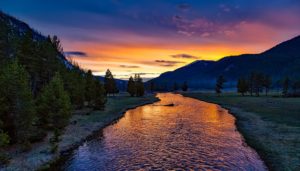A human can only live for 3 days without water. Even less so when energy is expended by a human to do things, like hunt, build shelters, or make tools. Even something like environmental temperature lessens this, as weather that is too hot will make you perspire and make you lose a lot of hydration.
To that end, you have a very limited timeframe to find water, among other things, that you can use to keep you alive. While showers and laundries are good, water is what keeps us hydrated and living to do the other tasks to keep us alive even further.
The rule of 3s dictate that finding a shelter is a priority, but this is not always the case. When you are dying of dehydration, you don’t focus on making a lean-to for the night, you focus on finding water to ensure that you can even make it to the night in the first place! Dehydration can occur as early as six hours without water!
Here, this article will examine ways that you can find water in a survival situation.
Different bodies of water
Streams, lakes, rivers, and the like are common occurrences in forests.
Most of the time, it should not take you too long to find a body of water, especially if you have something like a map of the area in question (or a good memory of a map). They can extend far and wide across an area, so even just walking in a straight line will likely help you find one.
If you listen closely, you might be able to hear the sound of rushing water from a raging body of water, indicating that you are near one of them.
Seawater
Seawater counts as a body of water if you are near the ocean or sea, but you can’t just drink it as is.
You will need to separate it from its components first, otherwise drinking it will just make you thirstier than you already are.
An effective way to do so is via distillation, where all you need are two differently sized containers, a cover, and sunlight. Place the smaller container inside the larger one, and have the water evaporate to the cover and drip droplets into the smaller one to clear it from its salty materials.
Watch for presence of animals
If you are a hunter, then one of the things you probably take advantage of is a spot where deer gather to drink as they, too, are living creatures, they need to find water to hydrate themselves and survive. If you manage to find an animal of sorts nearby, be it a deer, a bird, or a bee, then they may be near a body of water.
For mammals and birds, they usually drink at dawn and dusk. Insects like bees, on the other hand, are a sure sign that water is nearby, as their hives are always within 4 miles of water. Ants, on the other hands, may be following a column on a tree as the tree may have trapped water inside of it.
Not all animals are good indicators, however, not because they don’t drink, but because they drink too infrequently that it might be too late for you if you follow them for too long, such as birds of prey likes hawks. Carnivorous animals, on the other hand, get most of their hydration from the meat of the animals they consume, so you won’t get a lot of water hints by following them around.
Wait for rain
Rainwater is clean, unless you are unlucky enough to encounter acid rain instead (which is a very unlikely occurrence). It may actually be the cleanest source of water you can obtain naturally without having to purify or boil anything.
You can instantly get your fill of water by having your mouth open and letting the water inside your body, as the rain drips inside. But you will want to save as much of this water as you can, so in addition, have multiple containers that can catch rainwater prepared.
You can use a tarp that catches the rainwater and runs it into your containers to ensure that not too much of it is wasted.
Plants
The common depiction in media is to cut open cacti for its water, which is true, but it is not the only plant you can get water out of.
Vines, bamboo, and tree roots may contain water as well, but exercise caution, as they may be poisonous.
In the morning, plants are covered with due, which you can catch by using a cloth and then wringing it into a container.
The ground
Yes, those shows where people dig under to find water are right to an extent. Though, while you are not likely to hit a pipeline with water, you may find water by digging under wet dirt or sand. This usually goes hand in hand with green vegetation on top of it. It may need to be filtered, but it is perfectly drinkable otherwise.
Snow
Snow is literally just frozen water. In a cold environment, you can consume it as is to gain its hydration effects, but it is more recommended to melt it on a fire first, as to not lower your body temperature (which is important in a very cold climate). Though you may want to prioritize ice over snow if available, as you will be getting more water out of the former.
If you have no water, put ice or snow in a container like your water bottle and hide it under your clothes. It will eventually melt due to your own body heat.
Finishing Up
Water is a particularly important resource, which is why it is vital to find it as soon as possible to ensure your survival.
However, not all bodies of water are clean, so make sure to filter it and boil it to eliminate bacteria and parasites, as well as filthy material like dirt.

